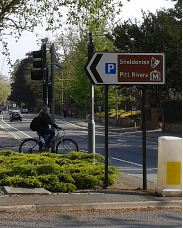 “Many are stubborn in pursuit of the path they have chosen. Few in pursuit of the goal.”
Friedrich Nietzsche
Why does that matter? Because as circumstances change, the path has to change. Your objective, your destination, remains the same, but the path you need to take to get there has to take account of unforeseen obstacles, newly-visible short cuts, etc. Obstinately pursuing the original path may lead you into unnecessary difficulties or delays, or even to somewhere different altogether. Of course that assumes that you knew where you were going in the first place. In my experience, often people are unwilling or even unable to define their goals really clearly. If you don't do that, all you have left to cling to is the path you have chosen - even when it is leading you to the wrong place!
I’ve been told that, faced with an impending pile-up on the road in front of you, you are most likely to avoid it if you keep your eyes on the space you need to drive into, not on the car you are about to hit – but to do so is very hard! Similarly, being flexible enough to adapt the path you take through change, while keeping your eyes on the ultimate goal, is most likely to deliver what you wanted. Most of my work is concerned with 'soft' projects where the ability to flex when circumstances change is key. Nietsche captured the problem beautifully.
“Many are stubborn in pursuit of the path they have chosen. Few in pursuit of the goal.”
Friedrich Nietzsche
Why does that matter? Because as circumstances change, the path has to change. Your objective, your destination, remains the same, but the path you need to take to get there has to take account of unforeseen obstacles, newly-visible short cuts, etc. Obstinately pursuing the original path may lead you into unnecessary difficulties or delays, or even to somewhere different altogether. Of course that assumes that you knew where you were going in the first place. In my experience, often people are unwilling or even unable to define their goals really clearly. If you don't do that, all you have left to cling to is the path you have chosen - even when it is leading you to the wrong place!
I’ve been told that, faced with an impending pile-up on the road in front of you, you are most likely to avoid it if you keep your eyes on the space you need to drive into, not on the car you are about to hit – but to do so is very hard! Similarly, being flexible enough to adapt the path you take through change, while keeping your eyes on the ultimate goal, is most likely to deliver what you wanted. Most of my work is concerned with 'soft' projects where the ability to flex when circumstances change is key. Nietsche captured the problem beautifully.  The other night I was meeting a friend for dinner in town. You know how sometimes when you get down to the tube platform it feels wrong? It felt wrong. Too many people, milling about with resigned looks, not purposefully waiting. Then the public announcement: “the Victoria line is suspended from Victoria to Walthamstow Central. There is a shuttle service operating between Brixton and Victoria.”
No train. No boards telling you when the next train is coming either. I have a choice: I can take the chance of waiting, hoping that if a train does come soon I might still be on time – but it might be ages; or I can go out and catch a bus – I will definitely be a bit late, but I know it will definitely come?
The other night I was meeting a friend for dinner in town. You know how sometimes when you get down to the tube platform it feels wrong? It felt wrong. Too many people, milling about with resigned looks, not purposefully waiting. Then the public announcement: “the Victoria line is suspended from Victoria to Walthamstow Central. There is a shuttle service operating between Brixton and Victoria.”
No train. No boards telling you when the next train is coming either. I have a choice: I can take the chance of waiting, hoping that if a train does come soon I might still be on time – but it might be ages; or I can go out and catch a bus – I will definitely be a bit late, but I know it will definitely come?
How do we deal with risk?
It’s a nice example of how we human beings deal with risk. I don’t know about you, but my thought process goes something like this. First I will take the higher risk option – perhaps partly because it is where I am. As I wait, and nothing happens, I weigh up how late I am going to be if I catch the bus. At some point (if I am still waiting) I decide to cut my losses – either way I’m going to be late, so I opt for the more certain course and catch the bus. This time, I waited 10 minutes before changing to Plan B, and was 20 minutes late. If I had changed immediately I would only have been 10 minutes late. It’s not very rational – the sensible thing surely is to take the low risk option as early as possible, minimising the lateness, rather than just hoping that Plan A will avoid us being late at all, and then finishing up being later than we needed to be. But it seems to be human nature to take the optimistic view like this. Usually when we have to deal with risk there is some kind of pain threshold we have to exceed before we are willing to consider an alternative course, even though the sensible point to do so may have been much earlier. I don’t know how much unnecessary pain we suffer as a result, but I suspect it is significant! Do you need help identifying the change options you have to deal with risk? Please get in touch. I’m on my way to a Board meeting. My job as a Board member is to turn up about once a month for a meeting lasting normally no more than a couple of hours to take the most important decisions the company needs – decisions which are often about complex areas, fraught with operational, commercial, legal and possibly political implications, and often with ambitious managers or other vested interests arguing strongly (but not necessarily objectively) for their preferred outcome. Few of the decisions are black and white, but most carry significant risk for the organisation. Good outcomes rely on informing Board members effectively.
This is a well-managed organisation, so I have received the papers for the meeting a week in advance, but I have had no chance to seek clarification of anything which is unclear, or to ask for further information. In many organisations, the papers may arrive late, or they may have been poorly written so that the story they tell is incomplete or hard to understand (despite often being very detailed), or both. The Board meeting, with a packed agenda and a timetable to keep to, is my only chance to fill the gaps.
I have years of experience to draw on, but experience can only take me so far. Will I miss an assumption that ought to be challenged, or a risk arising from something I am not familiar with? If that happens, we may make a poor decision, and I will share the responsibility. In some cases – for instance a safety issue - that might have serious consequences for other people. It’s not a happy thought.
I’m on my way to a Board meeting. My job as a Board member is to turn up about once a month for a meeting lasting normally no more than a couple of hours to take the most important decisions the company needs – decisions which are often about complex areas, fraught with operational, commercial, legal and possibly political implications, and often with ambitious managers or other vested interests arguing strongly (but not necessarily objectively) for their preferred outcome. Few of the decisions are black and white, but most carry significant risk for the organisation. Good outcomes rely on informing Board members effectively.
This is a well-managed organisation, so I have received the papers for the meeting a week in advance, but I have had no chance to seek clarification of anything which is unclear, or to ask for further information. In many organisations, the papers may arrive late, or they may have been poorly written so that the story they tell is incomplete or hard to understand (despite often being very detailed), or both. The Board meeting, with a packed agenda and a timetable to keep to, is my only chance to fill the gaps.
I have years of experience to draw on, but experience can only take me so far. Will I miss an assumption that ought to be challenged, or a risk arising from something I am not familiar with? If that happens, we may make a poor decision, and I will share the responsibility. In some cases – for instance a safety issue - that might have serious consequences for other people. It’s not a happy thought.
Informing Board members
In order for a Board (or any other body) to make good decisions, it has to be in possession of appropriate information. These are some of the rules I have followed when I have set up arrangements to promote effective governance.Good papers
Good papers tell the story completely and logically, but concisely. They do not assume that the reader knows the background. They build the picture without jumping around, and make clear and well-argued recommendations. They do not confuse with unnecessary detail, but nor do they overlook important aspects. As Einstein said, “If you can't explain it simply, you don't understand it well enough." Provide rules on length, apply (pragmatic) quality control to the papers received, and refuse to include papers if they do not meet minimum requirements (obviously it helps to be able to give advice on how to make them acceptable). You must of course choose a reviewer whose judgements will be respected. This may well result in some painful discussions, but people only learn the hard way.Timely distribution
If members do not have time to read the papers properly, it does not matter how good they are. If I am a busy Board member, I may need to reserve time in my diary for meeting preparation, and this is a problem if I cannot rely on papers arriving on time. Set submission deadlines which allow for timely and predictable distribution, and enforce them. Again, be prepared for some painful discussions until people learn.Informal channels
Concise papers and busy Board meetings are never going to allow for deep understanding of context. To overcome this, I have organised informal sessions immediately preceding Board meetings, over a sandwich lunch if the timing requires. Allocate a couple of hours for just two or three topics; bring in the subject experts, but spend most of the time on discussion. Not all Board members will be able to attend every session, but in my experience not only have they found them hugely valuable in building their wider knowledge of the business, but the opportunity to meet more junior staff has been appreciated all round. There are many other ways that informal channels could be set up. Different things will work in different organisations. Key to all of them is building trust: informing Board members properly means allowing them to see things “warts and all”, and trusting a wider group of staff to talk to them.Organisation
To do all of these things effectively, you need to have someone (or in larger organisations a small secretariat team) whose primary objective is to deliver them. This is not glamorous stuff, however important, and it easily gets put to the bottom of the pile without clear leadership. Finally, remember that nothing will happen unless the importance of this is understood at the very top. If the CEO does not set an example by sticking to time and quality rules, no one else will. A few years ago, I spent a fascinating week travelling around Europe. I was trying to put together a consortium to bid for funding from an EU industrial research programme. I was selling a vision. It was one of those “if its Wednesday I must be in France” trips, where after a couple of days my brain’s language processor gets so confused it just gives up attempting anything except English. Fortunately (but as usual), my hosts all put me to shame by speaking excellent English to me.
This trip taught me a very important lesson about selling a vision which I have used many times since. No organisation wants to be the first to commit to partnering when all they have is an outline description of the objectives of the partnership. They feel they need to know who else will be a part of it, and what the content of the programme will look like. Without this, they don’t even really want to share their ideas of what they might contribute or what benefits they might receive. On the other hand, until they do share their ideas it is impossible to put together a realistic programme. So where do you begin?
I describe what I did as “Castles in the air”. Think of the project as a fairy-tale castle floating above the ground. You have to be able to describe in some detail what this castle looks like from a distance. Of course, no-one can actually get to it to look inside, so much of the detail does not need to be filled in, but the description has to be convincing enough that everyone believes it is a real castle, not an illusion. In particular, they must never think that there is nothing holding it up!
A few years ago, I spent a fascinating week travelling around Europe. I was trying to put together a consortium to bid for funding from an EU industrial research programme. I was selling a vision. It was one of those “if its Wednesday I must be in France” trips, where after a couple of days my brain’s language processor gets so confused it just gives up attempting anything except English. Fortunately (but as usual), my hosts all put me to shame by speaking excellent English to me.
This trip taught me a very important lesson about selling a vision which I have used many times since. No organisation wants to be the first to commit to partnering when all they have is an outline description of the objectives of the partnership. They feel they need to know who else will be a part of it, and what the content of the programme will look like. Without this, they don’t even really want to share their ideas of what they might contribute or what benefits they might receive. On the other hand, until they do share their ideas it is impossible to put together a realistic programme. So where do you begin?
I describe what I did as “Castles in the air”. Think of the project as a fairy-tale castle floating above the ground. You have to be able to describe in some detail what this castle looks like from a distance. Of course, no-one can actually get to it to look inside, so much of the detail does not need to be filled in, but the description has to be convincing enough that everyone believes it is a real castle, not an illusion. In particular, they must never think that there is nothing holding it up!
Selling a vision
Putting that into project terms, there has to be a clear vision of what the project could do, broadly who may be involved and how they will benefit, even though none of it is agreed, and you have to feel and sound confident about it, just in order to get people talking about how they might contribute. Once you can get possible contributors to engage, they will help you fill in the detail, adapt the vision and underpin it with the foundations, until the whole project is solid enough to stand up by itself. The same principles apply to any situation where you need to influence many different people to win their support for the same idea. Unless you can describe your “castle in the air” with confidence, as though it were real and solid, it will be very difficult to get a hearing at all. The more people listen and contribute, even if they are not yet fully convinced, the easier it gets to win over others. I have recently moved house. I moved from a small and very ordinary town in Oxfordshire to a bustling area of London. What a contrast! From largely white to multi-cultural, from sleepy to vibrant, from staid dormitory to entrepreneurial.
One of the big differences is shopping. In Oxfordshire, there was little choice but to buy all your groceries from one of the big supermarkets. When I first lived there, there were many butchers, greengrocers and bakers. Over the years they have all shut up shop, unable to compete with the demand for the convenience of "all I need under one roof" and "open when I get home from work", even if supermarket prices can be high. Here I am spoilt for choice, especially with butchers, fishmongers and greengrocers. What a delight to be able to wander up and down the stalls, with the noise of vendors shouting out offers, with the bright colours of peppers, tomatoes, oranges and lemons and the indefinable smells, looking for the freshest, the fattest, and (wishfully) the tastiest.
I have recently moved house. I moved from a small and very ordinary town in Oxfordshire to a bustling area of London. What a contrast! From largely white to multi-cultural, from sleepy to vibrant, from staid dormitory to entrepreneurial.
One of the big differences is shopping. In Oxfordshire, there was little choice but to buy all your groceries from one of the big supermarkets. When I first lived there, there were many butchers, greengrocers and bakers. Over the years they have all shut up shop, unable to compete with the demand for the convenience of "all I need under one roof" and "open when I get home from work", even if supermarket prices can be high. Here I am spoilt for choice, especially with butchers, fishmongers and greengrocers. What a delight to be able to wander up and down the stalls, with the noise of vendors shouting out offers, with the bright colours of peppers, tomatoes, oranges and lemons and the indefinable smells, looking for the freshest, the fattest, and (wishfully) the tastiest.
The right price
One thing though took me by surprise. The price of bananas. Most of the market fruit and vegetables are good value by comparison with the supermarkets. But bananas? I’d guess the market price is about double the price in supermarkets! What is the right price? What is going on? The big chains compete with each other, not with market traders. If one shop puts a price down, the others pretty much follow suit. If one decides that bananas are to be a loss-leader, probably the rest do too. And this sort of pricing is like a ratchet – if it becomes established, it is very hard to move it in the other direction. The supermarkets may paint themselves into a corner. Pricing matters – and not just because companies exist to make a profit. Price sends a signal about what something is worth. “You get what you pay for” as the saying goes. Paradoxically, you may get more people coming to an event for which they have to buy a ticket than will come to one that is free, because the free event is not valued. Needing an income, I once took a job which paid considerably less than I had previously been earning. Result? I got very bored because no-one thought to use my higher skills. I was pigeon-holed by my price, and I left as soon as I could. Pricing that does not match value may serve a necessary short term purpose, but in the end it serves no-one very well. The right price matters. Years ago, I was managing the sale of a business division. The business was based on carrying out a highly-specialised technical test on clients’ products, and each time a test was carried out, it made a loud bang. This would have been of no concern if it had not been that they were carried out in a large workshop also used for other activities. However, checks had been made and the noise levels were within legal safety limits.
Just before signing the deal, we happened to mention to the purchaser that we had some tests scheduled for the next day, and he said he’d like to send someone round to check the sound levels. It was a beautiful summer’s day – until their measurements showed that the bangs were over the limit. What a toe-curling moment! Clearly, we had made the wrong assumptions.
In the end it was not as bad as it seemed: a sound-attenuating box solved the problem without making access too difficult, at quite modest cost and with only a few weeks’ delay. But the proving tests provided another surprise – the noise levels were legal again without the box. The reason – we now realised – was that the humidity of the air could affect its sound-attenuating properties.
Years ago, I was managing the sale of a business division. The business was based on carrying out a highly-specialised technical test on clients’ products, and each time a test was carried out, it made a loud bang. This would have been of no concern if it had not been that they were carried out in a large workshop also used for other activities. However, checks had been made and the noise levels were within legal safety limits.
Just before signing the deal, we happened to mention to the purchaser that we had some tests scheduled for the next day, and he said he’d like to send someone round to check the sound levels. It was a beautiful summer’s day – until their measurements showed that the bangs were over the limit. What a toe-curling moment! Clearly, we had made the wrong assumptions.
In the end it was not as bad as it seemed: a sound-attenuating box solved the problem without making access too difficult, at quite modest cost and with only a few weeks’ delay. But the proving tests provided another surprise – the noise levels were legal again without the box. The reason – we now realised – was that the humidity of the air could affect its sound-attenuating properties.
Avoiding wrong assumptions
Conclusion 1 – Make sure you know what factors can affect your assumptions. Wrong assumptions may lead to disaster. Conclusion 2 – Don’t rely on conclusion 1! If something is critical, don’t rely on a modest safety margin – do what you can to increase it early, in case there is something you have not anticipated. Have you ever noticed how the crowds waiting for commuter trains at Paddington (or doubtless most other big terminus stations) nearly all stay on the concourse until the platform is announced, even though each train usually runs from the same platform every day (so the regular commuters who are the majority all know which it is likely to be)? Consequence – a great crush as everyone rushes at the ticket barriers at once.
Have you ever noticed how the crowds waiting for commuter trains at Paddington (or doubtless most other big terminus stations) nearly all stay on the concourse until the platform is announced, even though each train usually runs from the same platform every day (so the regular commuters who are the majority all know which it is likely to be)? Consequence – a great crush as everyone rushes at the ticket barriers at once.
Beating the crowd
There are always a small number of people who don’t wait. They go calmly through the barrier with no queues, and get seats exactly where they want, beating the crowd instead of risking no seat at all. Maybe once in a blue moon the platform is different and they have to move – but it’s rare. It’s a great illustration of how conformist people (or at least we Brits) tend to be. I would guess less than 5% make the rational risk-reward trade-off and act accordingly, beating the crowd. 95% of us prefer to be part of the herd – but I wonder whether it is the people you would expect? Now there’s an interesting way to separate the sheep from the goats! Given those proportions, it is hardly surprising that very few people embrace change before they have to – even if they would stand to benefit from being early adopters. On the other hand, as change managers we have no need to wait until everything is ready before making announcements, unlike station staff. Early communication leads to more organised loading! Oxford is a city that is full of tourists, and in the UK where there are tourists, there are brown signs to direct them to the attractions. As well as the name of the attraction, a sign often also has what might best be called (by analogy with IT) an icon. The sign in the picture shows the word ‘Sheldonian' and a mask – the icon for a theatre. As you might guess, it directs you to the Sheldonian Theatre. So far so good.
There is just one problem. The theatre in question is not a place where you go to see plays. It is in fact the main ceremonial building of the university, where amongst other things, students are admitted, and all being well, later receive their degrees. I don’t suppose it confuses proud parents attending the ceremony, but I wonder what less well-informed tourists make of it?
Oxford is a city that is full of tourists, and in the UK where there are tourists, there are brown signs to direct them to the attractions. As well as the name of the attraction, a sign often also has what might best be called (by analogy with IT) an icon. The sign in the picture shows the word ‘Sheldonian' and a mask – the icon for a theatre. As you might guess, it directs you to the Sheldonian Theatre. So far so good.
There is just one problem. The theatre in question is not a place where you go to see plays. It is in fact the main ceremonial building of the university, where amongst other things, students are admitted, and all being well, later receive their degrees. I don’t suppose it confuses proud parents attending the ceremony, but I wonder what less well-informed tourists make of it?
Poor branding
I won’t speculate on whether the person who designed the sign realised what they were doing, but it reminded me of an important business truth. Broadly interpreted, what happened here was poor branding – the icon was inconsistent with the meaning, potentially leading to confusion and frustration. The importance of consistency and integrity of messages is universal, whether or not the messages we are giving would conventionally be thought of as branding. When everything we see and hear is consistent, we believe in the authenticity of the message, and that builds trust, be it in a product, an organisation, a person, or a set of signs. When we realise that that consistency is lacking, trust is lost - even if only in the brown signs. Any time you want to build trust, think of yourself as managing your own brand. As change managers, the ability to build trust is one of our most important skills – so we can't afford poor branding. Whatever and however you are communicating (particularly when you are not deliberately communicating at all!), be authentic – then you will also have that essential consistency. Perhaps it does not matter if one set of signs has an odd choice of image, or just how much the signs are trusted. But how many times have you made similar mistakes, which may have had worse consequences?
Review of 11 Rules for Creating Value in the Social Era by Nilofer Merchant
 Perhaps surprisingly, given the title, Nilofer Merchant’s short book is not so much about the ‘how’ of social media, as the paradigm shift it has enabled in the way that most of the world does business.
In the old days, ‘efficiency’ – doing things right – ruled. You made more money by having more efficient processes, and by having the scale to cover your high fixed costs easily. Large dominant players with efficient processes made it almost impossible for small companies to overcome the barriers to entry. In the past those approaches may also have been ‘effective’ – doing the right things – but the context has changed.
In the new world, while scale and efficiency can be good strategies where there are low levels of innovation and change, the inherently cautious response of big, efficient organisations becomes a disadvantage: the ‘right things’ change too fast. High rates of innovation and change have become possible through the power of social media. Merchant says that a new approach is needed, based on embracing what social media enables, characterised by
Perhaps surprisingly, given the title, Nilofer Merchant’s short book is not so much about the ‘how’ of social media, as the paradigm shift it has enabled in the way that most of the world does business.
In the old days, ‘efficiency’ – doing things right – ruled. You made more money by having more efficient processes, and by having the scale to cover your high fixed costs easily. Large dominant players with efficient processes made it almost impossible for small companies to overcome the barriers to entry. In the past those approaches may also have been ‘effective’ – doing the right things – but the context has changed.
In the new world, while scale and efficiency can be good strategies where there are low levels of innovation and change, the inherently cautious response of big, efficient organisations becomes a disadvantage: the ‘right things’ change too fast. High rates of innovation and change have become possible through the power of social media. Merchant says that a new approach is needed, based on embracing what social media enables, characterised by
- Community: A far more flexible way of allocating work;
- Creativity: Allowing co-creation of value with customers;
- Connections: A more open approach than in the past to customer relationships.


